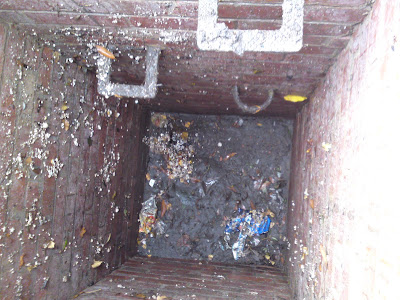
No time for myself, gales, flooding, long hours at work sorting out flooding, blocked drains, damage, dismantling trees, etc.
Partially blocked.

Oh dear, This one's been full to the top, see the debris on the sides? Water gets away, but only at a certain rate. If the rain fall is above the rate at which the drain can soak away into the earth, this will fill, and overflow. The top of this chamber is six feet above the nearby building's floor level. And there's a basement ten feet below that.
Looks harmless enough, doesn't it?
It's about ten feet deep, the old step irons have broken off further down. Not allowed to use them, these days, anybody going down there need to be lowered by winch, wearing a recovery harness and gas detector. It looks harmless enough, but methane gas, carbon dioxide and carbon monoxide can pool in the bottom of holes like this. The person who goes down becomes unconscious quite rapidly, and then a rescuer goes down, and the same thing happens.
Repeatedly.
Repeatedly.
"On July 26, 1989, five farm workers died after consecutively entering a manure pit on their farm. The pit measured 20 by 24 feet and was 10 feet deep. The victims were a 65-year-old dairy farmer, his two sons aged 37 and 28, a 15-year-old grandson, and a 63-year-old nephew. The younger son initially entered the pit to replace a shear pin on an agitator shaft. (NOTE: Agitation of the manure, which is required to facilitate transfer, causes a rapid release of the gases formed during decomposition.) While attempting to climb out of the pit, the initial victim was overcome and fell to the bottom. The grandson then entered the pit to attempt a rescue. He too was overcome and collapsed. The nephew, the older son, and the dairy farmer then entered the pit one at a time, attempting to rescue those already overcome. Each was overcome and collapsed in turn. A carpet installer working at the farm house then entered the pit to attempt a rescue. He too was overcome but was rescued by his assistant and subsequently recovered. Finally, the owner of a local farm implement business arrived on the scene with two of his workers and, using a rope, extricated the five victims from the pit. When the local emergency rescue squad arrived on the scene approximately 20 minutes after the incident, they immediately began cardiopulmonary resuscitation. The nephew was pronounced dead at the scene. The remaining four victims were transported to the local hospital. The farmer and his younger son were pronounced dead on arrival, and the older son died an hour after reaching the emergency room. The grandson was transferred to a major trauma center by helicopter but he died approximately 6 hours after his removal from the pit. Reports of the medical examiner cite methane asphyxiation as the cause of these five deaths [NIOSH 1989c]. "
Best way to do it is to cheat, call for a big suction tanker:-

Then you suck all the gloop out (technical term:-"gloop"), jet the line up and down with high pressure water, stick the four-wheel-drive remote camera in and take a virtual journey along the pipe, looking for cracks, debris, roots, and collapses. In this case, there's a collapsed section and tree roots about 100 ft outside our boundary line, so it's the city's mains drainage department's job to fix it, but access might be difficult for a full size backhoe, they might need minidiggers... and the beaurocratic ramifications of crossing multiple private properties to get there....
But we've informed them of it, and given them the camera footage to show the problem, so if there's another deluge, and businesses on our site get flooded, then the claims will be against the city, not us. We can prove our drains are clear and properly maintained.
Best way to do it is to cheat, call for a big suction tanker:-

Then you suck all the gloop out (technical term:-"gloop"), jet the line up and down with high pressure water, stick the four-wheel-drive remote camera in and take a virtual journey along the pipe, looking for cracks, debris, roots, and collapses. In this case, there's a collapsed section and tree roots about 100 ft outside our boundary line, so it's the city's mains drainage department's job to fix it, but access might be difficult for a full size backhoe, they might need minidiggers... and the beaurocratic ramifications of crossing multiple private properties to get there....
But we've informed them of it, and given them the camera footage to show the problem, so if there's another deluge, and businesses on our site get flooded, then the claims will be against the city, not us. We can prove our drains are clear and properly maintained.
Last bit of tree, a few bags of debris, and I can think of going home, to a hot bath, and early to bed. Bliss.

(in this last pic, you can see how the road level on one side of the building is at the same level as the rainwater gutters on the roofs. Any drain problem here can mean a big trouble inside.)

be kinda fun to toss a few lit fiecrackers down a drain full of methane, see what happens....
ReplyDeleteIt would probably burn fairly slowly, at first, yellow flame, then become turbulent, and there'd be a very big bang! Stand well back.
ReplyDeleteYou do drains different.
ReplyDeleteMax: ? Please explain.
ReplyDelete